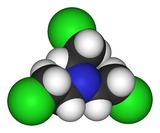Formula C6H12Cl3N Boiling point 143 °C Appearance Colourless liquid | Molar mass 204.53 g/mol Density 1.24 g/cm³ | |
 | ||
Related amines Related compounds | ||
Hn3 nitrogen mustard
Tris(2-chloroethyl)amine is the organic compound with the formula N(CH2CH2Cl)3. Often abbreviated HN3, it is a powerful blister agent and a nitrogen mustard gas (although it is not a gas) used for chemical warfare. HN3 was the last of the nitrogen mustard agents developed. It was designed as a military agent and is the only one of the nitrogen mustards that is still used for military purposes. It is the principal representative of the nitrogen mustards because its vesicant properties are almost equal to those of HD and thus the analogy between the two types of mustard is the strongest. As a vesicant the use and production is strongly restricted within the Chemical Weapons Convention where it is classified as a Schedule 1 substance.
Contents
Mode of action
Nitrogen mustards react via an initial cyclization to the corresponding quaternary aziridine salt. The rate of this reaction is pH dependent because the protonated amine cannot cyclize.
Applications
HN-3 has found some applications in chemotherapy, e.g., for Hodgkin's disease, and in some compound Semiconductor research but it is mainly of interest for its military uses and is the only one of these agents that remains anywhere as a military agent. These agents are more immediately toxic than the sulfur mustards.
Exposure
HN-3 can be absorbed into the body by inhalation, ingestion, eye contact, and skin contact (though inhalation is the most common). The chemical is extremely toxic and may damage the eyes, skin, and respiratory tract and suppress the immune system. HN-3 penetrates and binds quickly to cells of the body, but its health effects develop slowly. The full extent of cellular injury may not be known for days.
